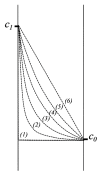Mathematical Modeling of Release Kinetics from Supramolecular Drug Delivery Systems
- PMID: 30901930
- PMCID: PMC6471682
- DOI: 10.3390/pharmaceutics11030140
Mathematical Modeling of Release Kinetics from Supramolecular Drug Delivery Systems
Abstract
Embedding of active substances in supramolecular systems has as the main goal to ensure the controlled release of the active ingredients. Whatever the final architecture or entrapment mechanism, modeling of release is challenging due to the moving boundary conditions and complex initial conditions. Despite huge diversity of formulations, diffusion phenomena are involved in practically all release processes. The approach in this paper starts, therefore, from mathematical methods for solving the diffusion equation in initial and boundary conditions, which are further connected with phenomenological conditions, simplified and idealized in order to lead to problems which can be analytically solved. Consequently, the release models are classified starting from the geometry of diffusion domain, initial conditions, and conditions on frontiers. Taking into account that practically all solutions of the models use the separation of variables method and integral transformation method, two specific applications of these methods are included. This paper suggests that "good modeling practice" of release kinetics consists essentially of identifying the most appropriate mathematical conditions corresponding to implied physicochemical phenomena. However, in most of the cases, models can be written but analytical solutions for these models cannot be obtained. Consequently, empiric models remain the first choice, and they receive an important place in the review.
Keywords: boundary conditions; diffusion equation; drug carriers; release kinetics.
Conflict of interest statement
The authors declare no conflicts of interest.
Figures











References
-
- Crank J. The Mathematics of Diffusion. 2nd ed. Oxford Clarendon Press; Oxford, UK: 1975.
-
- Carslaw H.S., Jaeger J.C. Conduction of Heat in Solids. 2nd ed. Oxford University Press; Oxford, UK: 1959.
-
- Voicu V.A., Mircioiu C. Mecanisme Farmacologice la Interfete Membranare [Farmacological Mechanisms at Membranar Interfaces] Ed Academiei; Bucharest, Romania: 1994.
-
- Bolisetti S.S., Reddy M.S. Formulation and in-vitro evaluation of gastro retentive in-situ floating gels of repaglinide cubosomes. J. Pharm. Res. 2013;6:787.
Publication types
LinkOut - more resources
Full Text Sources
Other Literature Sources

